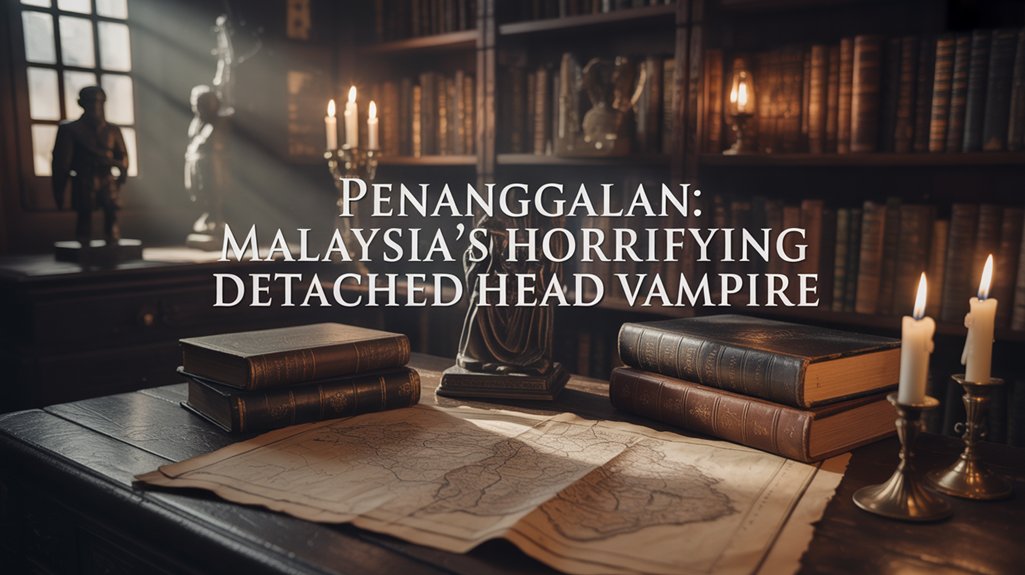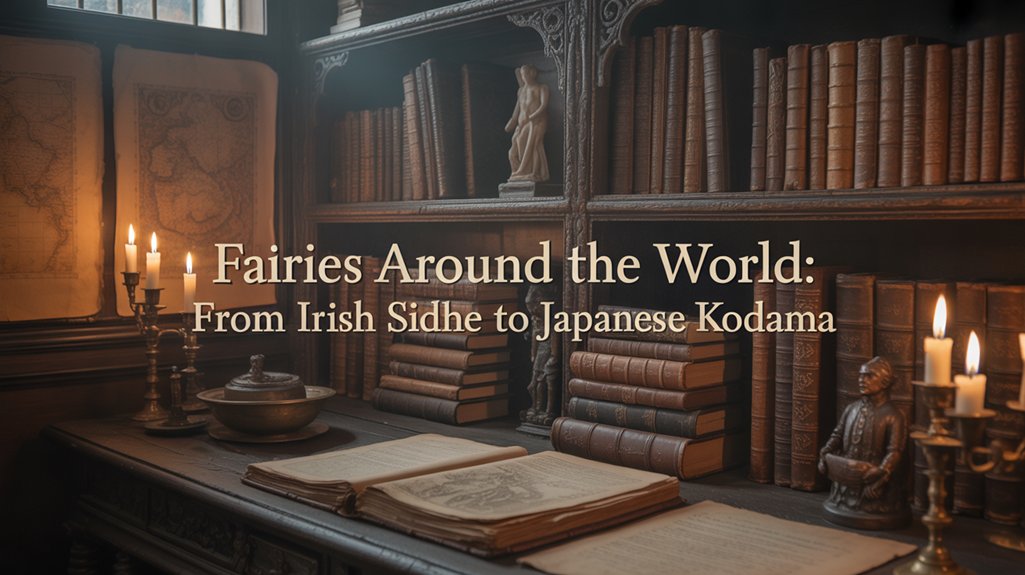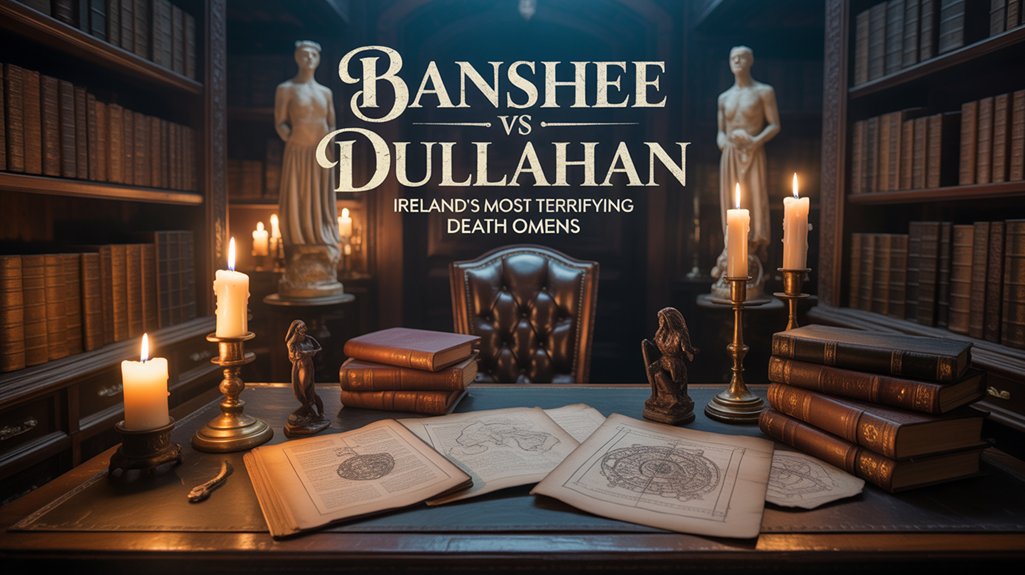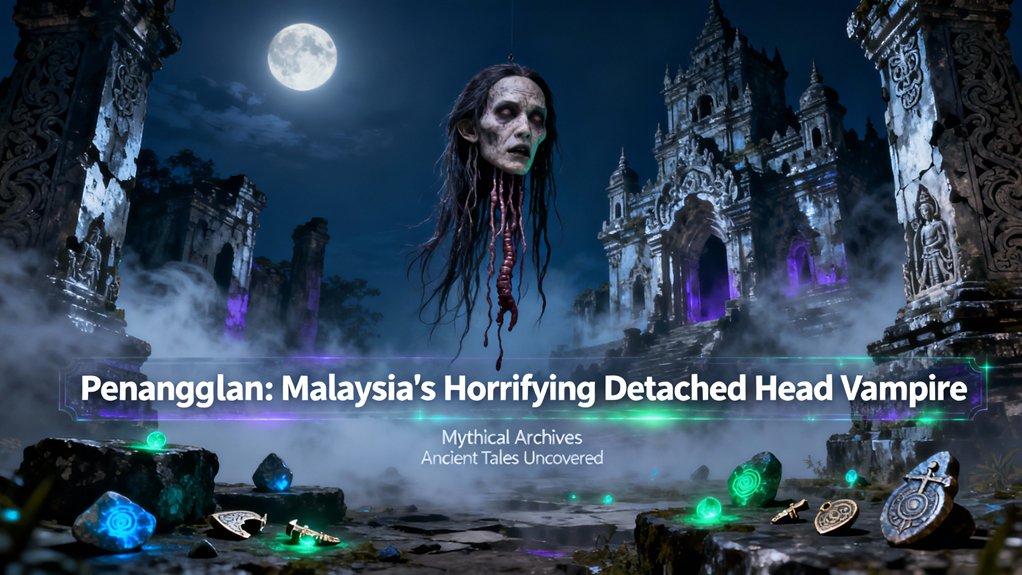
You’ll encounter the penanggalan in fifteenth-century Malay texts—a chimeric predator born from forbidden ilmu hitam that alters women into severed heads trailing phosphorescent entrails through tropical nights. This creature, rooted in pre-Islamic animistic traditions across the Nusantara archipelago, targets pregnant women and newborns with eldritch precision, detecting victims from remarkable distances. Communities developed sophisticated defenses: thorny barriers, jeruju leaves, protective verses, and vinegar traps to ensnare the hunting head. Modern cinema and graphic novels have changed this visceral folklore into international horror currency, preserving its essential terror while exploring deeper cultural dimensions.
Table of Contents
ToggleKey Takeaways
- The Penanggalan is a Malaysian vampire appearing as a severed female head with glowing entrails that detach and fly at night.
- Transformation occurs through forbidden black magic rituals involving vinegar meditation, fasting, and blood concoctions over forty nights.
- It primarily hunts pregnant women, newborns, and postpartum mothers, detecting them by scent and entering through small openings.
- Traditional defenses include thorny plants, protective amulets, salt rings, and verses to ward off attacks on vulnerable households.
- Modern films and comics have revived the legend, transforming it into international horror while exploring feminist and postcolonial themes.
Origins and Cultural Significance of the Penanggalan Legend
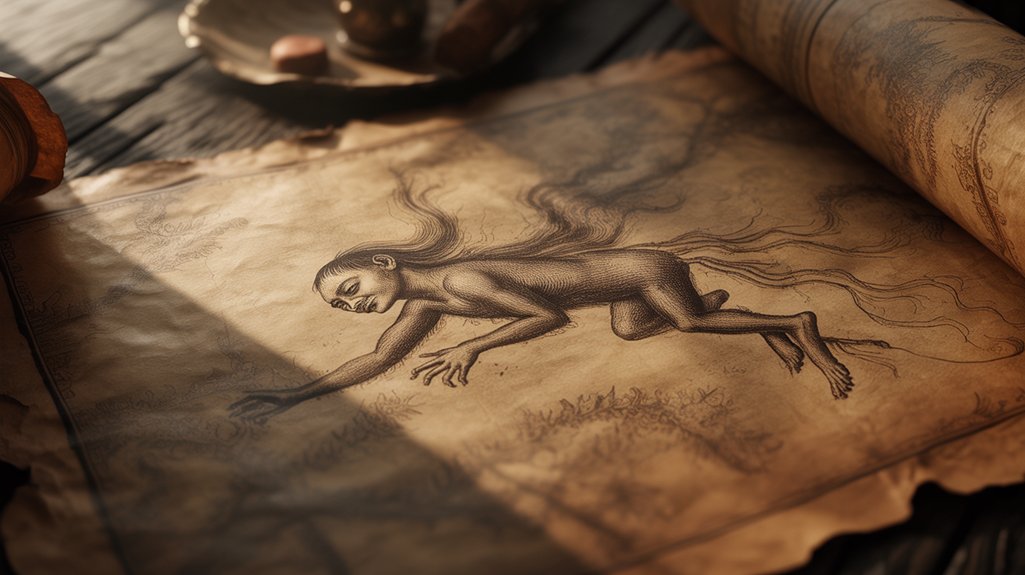
Though scholars trace the penanggalan’s earliest documented appearances to fifteenth-century Malay texts, the creature’s conceptual roots burrow deeper into the pre-Islamic animistic traditions of the Nusantara archipelago, where boundary-crossing entities haunted the threshold between corporeal existence and spectral dissolution.
The penanggalan’s origins transcend written records, emerging from ancient animistic traditions where entities transgressed the boundaries between flesh and spirit.
You’ll discover these cultural roots intertwining with Javanese, Bruneian, and Khmer folklore, each tradition contributing chimeric variations to the core mythology. The folklore significance extends beyond mere horror—this eldritch predator embodied anxieties surrounding female autonomy, bodily transgression, and spiritual contamination.
Colonial ethnographers documented variations throughout maritime Southeast Asia during the 1800s, though indigenous communities preserved these narratives for centuries prior. The penanggalan represented liminality itself: woman by day, detached viscera-trailing head by night.
This duality reflected deeper cosmological beliefs about permeable boundaries between human and supernatural domains, particularly during vulnerable moments—childbirth, menstruation, death. Understanding this context reveals how the legend functioned as both cautionary tale and metaphysical framework.
The Transformation Process: How Women Become Penanggalan
According to the most prevalent transmission narratives preserved across Malay kampung communities, a woman becomes penanggalan through deliberate invocation of forbidden ilmu hitam—black magic practices explicitly condemned by both Islamic and indigenous spiritual frameworks.
You’ll discover that female alteration requires prolonged meditation in earthenware jars filled with vinegar, a corrosive agent weakening the neck’s corporeal bonds until separation becomes possible. The mythological origins trace to pre-Islamic animist traditions, where women sought supernatural power through chimeric metamorphosis, trading their humanity for eldritch abilities.
The ritual demands forty nights of fasting, consuming only blood-infused concoctions. During this liminal period, the practitioner’s essence fractures, her head gaining sentience independent from her body.
Some accounts describe accidental alterations—women startled during meditation, their heads tearing free permanently. The process remains irreversible. Once severed, the penanggalan exists eternally suspended between life and death, cursed to hunt, forever embodying Southeast Asia’s darkest supernatural fears.
Physical Characteristics and Supernatural Abilities
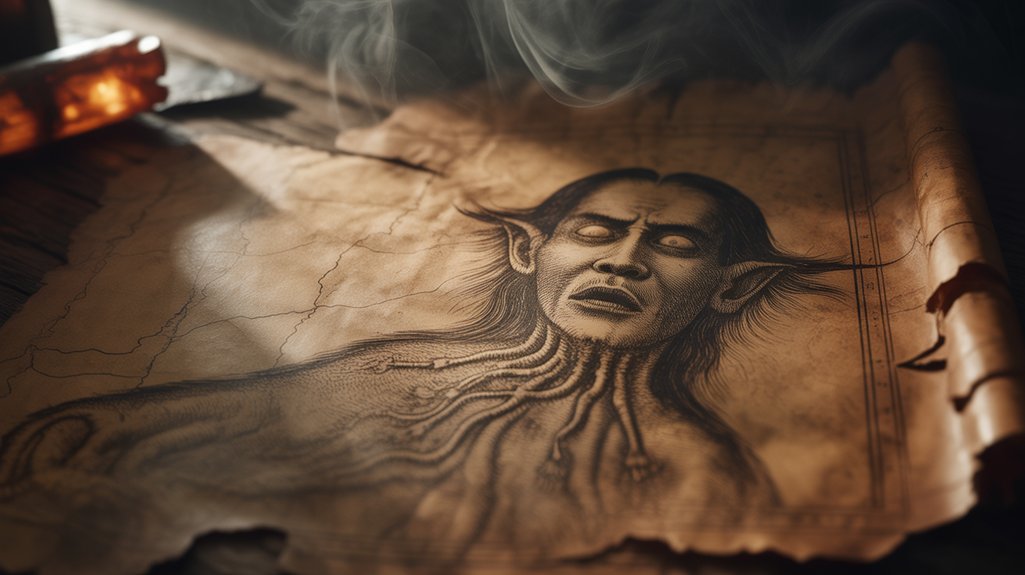
When darkness descends across Malaysian kampung settlements, the penanggalan manifests as a severed female head trailing its visceral appendages—esophagus, stomach, and intestines—in grotesque luminescent suspension.
You’ll witness vampire anatomy altered into eldritch horror: organs glowing with phosphorescent green light, dripping corrosive bile that burns vegetation upon contact. Her fanged visage retains human features while displaying chimeric corruption.
The creature’s supernatural traits enable vertical flight through coconut groves, entry through the smallest apertures beneath stilted houses. She detects pregnant women from remarkable distances, drawn by the scent of amniotic fluid and nascent life.
Her entrails function as prehensile appendages, capable of extending meters to reach victims through windows, beneath doors, between roof tiles.
Most terrifying: her tongue elongates impossibly, penetrating abdomens to extract blood from fetuses and placentas.
Salt, thorny plants, and broken glass repel her—these substances snag her delicate organs during attempted re-entry into her abandoned body vessel.
Hunting Patterns and Preferred Victims
The penanggalan’s predatory cycle aligns with lunar phases and reproductive rhythms, her nocturnal hunts intensifying during childbirth periods when villages maintain vigil against her arrival.
You’ll find her hunting techniques reveal methodical precision—she hovers near windows, her entrails dripping caustic fluids that burn through barriers, seeking the vulnerable scent of amniotic blood.
Victim profiles demonstrate consistent patterns:
- Pregnant women in their final trimester, radiating life-force
- Newborns still tethered to their mother’s essence
- Women experiencing postpartum recovery, energetically depleted
- Midwives who’ve absorbed spiritual residue from multiple births
- Young children whose immune systems remain spiritually permeable
Her eldritch hunger transcends mere sustenance.
The penanggalan feeds upon generational continuity itself, severing bloodlines through chimeric predation.
You can’t dismiss this as primitive superstition—these hunting patterns reflect sophisticated understanding of human vulnerability, targeting moments when life hangs delicately between worlds, when protection wavers.
Protection Methods and Traditional Defenses
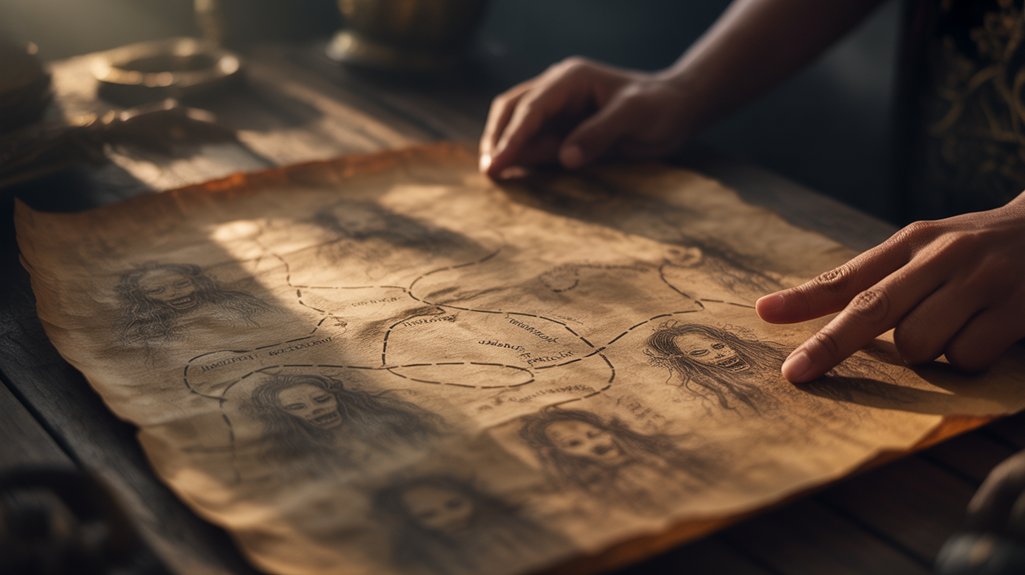
Against such calculated malevolence, Southeast Asian communities developed elaborate defensive architectures—both physical and metaphysical—that remain practiced in rural Malaysian kampungs today.
You’ll find thorns planted beneath windows, their spikes intended to pierce dangling entrails. Jeruju leaves, scattered across thresholds, create barriers the penanggalan can’t traverse. These botanical defenses merge with spiritual safeguards: protective charms inscribed with Quranic verses, Buddhist mantras, or pre-Islamic incantations depending on regional syncretism.
Amulet rituals performed during pregnancy provide the most essential protection. Midwives conduct elaborate ceremonies, binding expectant mothers with consecrated threads, administering herbal preparations to strengthen spiritual resilience.
The chimeric nature of these defenses—combining Islamic talismans with animistic practices—reflects Malaysia’s layered religious history.
Salt rings. Mirror placements to reflect eldritch energies back toward their source. Specific prayers uttered at twilight.
You’re witnessing protection systems refined across centuries, each generation adding empirical observations to ancestral wisdom, creating extensive countermagic against this particular horror.
Regional Variations Across Southeast Asia
Across archipelagic Southeast Asia, this predatory entity changes through cultural adaptation, acquiring distinct characteristics that reveal each society’s deepest anxieties about feminine power, bodily autonomy, and spiritual transgression.
Regional variations manifest through these chimeric forms:
- Krasue (Thailand/Laos): You’ll encounter glowing entrails trailing behind the luminescent head, organs pulsating with eldritch hunger as she drifts through rice paddies seeking placental blood.
- Leyak (Bali): She alters willingly through black magic meditation, her detached head hunting with extended tongue, practicing spiritual corruption through deliberate occult study.
- Manananggal (Philippines): Wings sprout from her severed torso—a bat-like monstrosity that bisects at the waist rather than neck, creating disturbing anatomical permutations.
- Palasik (Minangkabau): The head separates with stomach attached, targeting pregnant women specifically, embodying maternal jealousy changed into supernatural malevolence.
- Ap (Cambodia): She appears as floating head with dangling esophagus, consuming human waste and carrion.
These cultural adaptations reflect distinct cosmologies. Each iteration preserves core predatory essence while changing through local folklore.
Modern Interpretations in Film, Literature, and Popular Culture

You’ve witnessed how this eldritch entity altered across borders and centuries, yet the Penanggalan’s most startling metamorphosis occurred when filmmakers, novelists, and comic artists claimed her visceral, chimeric form for modern audiences.
From the 1975 Thai-Malaysian exploitation film *Krasue* to contemporary graphic novels like Colin Chan’s *Pontianak* series, creators have preserved the creature’s essential horror—the trailing entrails, the nocturnal hunt, the vulnerability of pregnant women—while amplifying her relevance through feminist reinterpretation, body horror aesthetics, and postcolonial commentary.
These adaptations don’t merely resurrect folklore; they change ancestral terror into contemporary cultural discourse, ensuring that the severed head’s midnight flight still haunts Southeast Asian consciousness in an age of digital screens and urban landscapes.
Penanggalan in Horror Cinema
While the Penanggalan remained largely confined to Southeast Asian folklore and oral traditions for centuries, the creature’s cinematic debut arrived with the 1967 Thai-Malaysian co-production “Lumba-Lumba Hantu” (Ghost Vampire), marking the beginning of its shift from village cautionary tale to visual horror spectacle.
You’ll discover how filmmakers altered penanggalan symbolism into visceral terror:
- Mystics (1981): Hong Kong’s Shaw Brothers exploited the creature’s grotesque imagery.
- Krasue Valentine (2006): Thailand’s romantic reimagining subverted traditional horror tropes.
- Dendam Pontianak (2019): Malaysian horror revived authentic folklore elements.
- Eerie (2018): Philippine cinema adapted the mythology through regional variations.
- Kuntilanak trilogy: Indonesian interpretations emphasized the creature’s eldritch nature.
These productions liberated the Penanggalan from anthropological obscurity, converting chimeric legends into international horror currency.
Literary Adaptations and Comics
Beyond the screen’s flickering shadows, the Penanggalan discovered new incarnations through ink and illustrated panels, where writers and artists could explore the creature’s horrific alterations without budgetary constraints.
Malaysian graphic novelists embraced this eldritch predator, employing narrative techniques that juxtaposed visceral body horror against postcolonial anxieties. The creature’s chimeric form—woman by day, detached viscera by night—became potent literary symbolism for fractured identity, colonial violence inscribed upon indigenous bodies.
Sequential art captured the Penanggalan’s anatomical terror with unprecedented detail: trailing intestines rendered in meticulous crosshatching, entrails glistening beneath moonlight.
Independent publishers in Kuala Lumpur, Singapore, and Jakarta converted oral traditions into contemporary mythology. These adaptations honored the creature’s Malay origins while interrogating gender, autonomy, and change.
Freedom through alteration. Horror as cultural reclamation.
Frequently Asked Questions
Can a Penanggalan Be Permanently Killed or Destroyed?
You’ll find permanent destruction possible through specific rituals documented in Malaysian supernatural beliefs.
Traditional vampire lore prescribes scattering thorny mengkuang leaves around the abandoned body—those sharp, eldritch points prevent the head’s return at dawn.
You might also destroy the entrails-dragging form by immersing the exposed organs in vinegar or holy water, inflicting irreversible damage.
Salt scattered across thresholds offers protection.
These aren’t mere superstitions; they’re sacred protocols, chimeric defenses rooted in ancestral wisdom against nocturnal predation.
Are There Documented Eyewitness Accounts of Penanggalan Encounters?
You’ll find documented eyewitness stories scattered throughout Malaysian colonial records and anthropological surveys from the 19th century onward, though Western scholars often dismissed them as superstition.
Village testimonies persist across generations—farmers describing luminescent entrails trailing through moonlit kampongs, midwives recounting eldritch encounters during birthing rituals.
These accounts reflect deeply-rooted cultural beliefs rather than empirical verification. The penanggalan exists within that liminal space where lived experience, ancestral memory, and chimeric folklore intertwine, defying neat categorization.
Can Men Become Penanggalan or Is It Exclusively Female?
You’ll find penanggalan lore consistently depicts exclusively female entities—no documented male alteration exists within Malaysian, Indonesian, or broader Southeast Asian traditions.
These gender myths anchor deeply in cultural anxieties surrounding feminine power, menstruation, and childbirth’s liminal mysteries.
The creature’s origin stories invariably feature women practicing forbidden meditation or dabbling in dark arts, their bodies betraying them through eldritch change.
Men remain observers, victims, never the chimeric predators themselves—a telling anthropological boundary.
How Does Pregnancy Affect a Woman’s Transformation Into a Penanggalan?
You’ll find pregnancy effects create profound alteration triggers in penanggalan lore.
Childbirth’s liminal state—that eldritch threshold between life and death—renders women exceptionally vulnerable to demonic pacts and supernatural metamorphosis.
The postpartum period, steeped in blood and visceral change, serves as a chimeric gateway.
Traditional Malay belief holds that mothers who practice forbidden meditations during confinement risk involuntary alteration, their maternal essence corrupted into predatory hunger.
Pregnancy doesn’t prevent penanggalan change—it accelerates it, exploiting your body’s mystical openness.
What Happens if a Penanggalan Cannot Reunite With Its Body?
You’ll face catastrophic detached consequences should dawn break before body reunion occurs.
Your exposed viscera withers under sunlight’s merciless rays, organs desiccating into brittle husks while your corporeal form languishes, abandoned.
Ancient Malay texts warn: without reunification, you’re condemned to eternal wandering—neither living nor dead, trapped in liminal torment.
The eldritch separation becomes permanent; your physical vessel decays beyond salvage, leaving you a chimeric specter doomed to supernatural exile.
Freedom converts into an unending prison of fragmented existence.
Conclusion
You’ve journeyed through eldritch folklore, confronted the chimeric horror of viscera trailing through moonlit kampongs. Yet the penanggalan persists—not merely as ancestral terror, but as living cultural memory. She embodies Southeast Asia’s deepest anxieties about feminine power, maternal vulnerability, colonial trauma. Ancient protection rituals still grace doorways. Modern cinema resurrects her flight. You can’t dismiss her as primitive superstition. She’s scholarship and shadow intertwined—proof that some truths transcend rational boundaries, dwelling eternally in that liminal space between belief and knowing.

